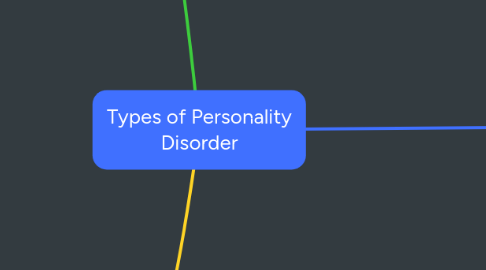
1. CLUSTER A
1.1. Paranoid
1.1.1. suspicious, do not trust
1.1.2. hold grudges, quick to interpret
1.1.3. reluctant to confide
1.2. Schizoid
1.2.1. donot like close relationships
1.2.2. rarely express emotions
1.2.3. indifferent to praise and criticism
1.3. Schizotypal
1.3.1. socially anxious and awkward
1.3.2. donot have friends
1.3.3. magical beliefs, vague speech, eccentric clothing
2. Trait theories
2.1. Big Five
2.1.1. Openess
2.1.2. Agreeableness
2.1.3. Extraversion
2.1.4. Neuroticism
2.1.5. Conscientiousness
2.2. Eysenck
2.2.1. extrovert
2.2.1.1. stable extroverts
2.2.1.2. unstable extroverts
2.2.2. neurotic
2.2.2.1. stable introverts
2.2.2.2. unstable intoverts
2.2.3. psychotic
2.3. Catell
2.3.1. 16 PF
2.3.2. Factor Analysis
3. CLUSTER C
3.1. Avoidant
3.1.1. avoid social situation due to fear of rejection n judgement
3.1.2. shy, easily hurt
3.1.3. unwilling to take risk or try new things
3.2. OCPD
3.3. Dependent
3.3.1. oversensitive
3.3.2. excessive attachment
3.3.3. clingy, fear of seperation
3.3.4. lack of confidence, avoid responsibility
4. Humanistic Theory
4.1. looks at people in positive light
4.2. Carl Roger and Maslow
4.3. at center of the theory is the need for self- actualization
5. Carl Jung
5.1. Mental Processes
5.1.1. Rational
5.1.1.1. Thinking
5.1.1.2. Feeling
5.1.2. Irrational
5.1.2.1. Sensing
5.1.2.2. Intuition
5.2. Personality Attitudes
5.2.1. Introversion
5.2.2. Extroversion
6. CLUSTER B
6.1. Histrionic
6.1.1. attention seeker
6.1.2. shallow emotion
6.1.3. outer appearance matters
6.1.4. easily influenced
6.1.5. dramatic emotions
6.2. Narcissist
6.2.1. grandiose
6.2.1.1. sense of superiority
6.2.1.2. overconfidence
6.2.1.3. entitlement
6.2.1.4. hostile
6.2.2. malignant
6.2.2.1. manuplative
6.2.2.2. malignant
6.2.2.3. sadistic
6.2.2.4. cruel n aggressive
6.2.3. vulnerable
6.2.3.1. neurotisicm
6.2.3.2. avoid critisicm
6.2.3.3. insecure and envious
6.2.3.4. do not trust
6.3. Borderline
6.3.1. fear of abandonment, feelings of emptiness
6.3.2. rapid mood changes
6.3.3. anger issues, self harm chances, impulsive behaviour
6.3.4. paranoid thoughts
6.4. Antisocial
6.4.1. irresponsible, dangerous
6.4.2. impulsive
6.4.3. hostile, risk takers
6.4.4. lack of remorse
6.4.5. Liers, deceitful
7. Psychodynamic Theory
7.1. Personality is a dynamic conflict between the impulse to seek release and the inhibition against these impulses.
7.1.1. Id
7.1.1.1. Pleasure principle
7.1.1.1.1. Unconscious
7.1.2. Ego
7.1.2.1. Reality principle
7.1.2.1.1. Preconscious
7.1.2.1.2. Subconscious
7.1.3. Superego
7.1.3.1. Ego ideal
